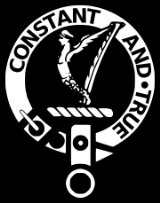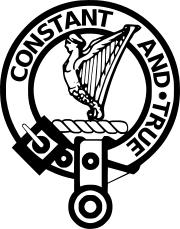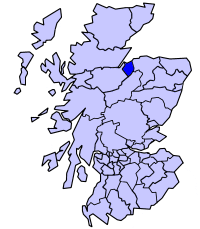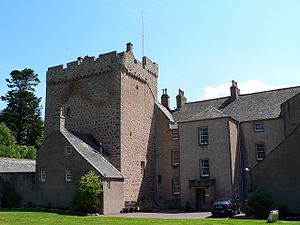
Clan Rose
Encyclopedia

Scottish Highlands
The Highlands is an historic region of Scotland. The area is sometimes referred to as the "Scottish Highlands". It was culturally distinguishable from the Lowlands from the later Middle Ages into the modern period, when Lowland Scots replaced Scottish Gaelic throughout most of the Lowlands...
Scottish clan
Scottish clan
Scottish clans , give a sense of identity and shared descent to people in Scotland and to their relations throughout the world, with a formal structure of Clan Chiefs recognised by the court of the Lord Lyon, King of Arms which acts as an authority concerning matters of heraldry and Coat of Arms...
. Their chief's motto is "Constant and True" and their chief's
family castle is Kilravock Castle
Kilravock Castle
Kilravock Castle is located near the village of Croy, between Inverness and Nairn, in Highland, Scotland. It was begun around 1460, and has been the seat of the Clan Rose since that time. The castle is a composite of a 15th century tower house and several later additions...
, built in 1460. The current chief of name and arms is Anna Elizabeth Guillemard Rose, 25th of Kilravock.
(Ross of Kilravock, is pronounced Ross of Kilraik)
History
.jpg)
Origins of the clan
The clan Rose was formed in the early 13th century in NairnNairn
Nairn is a town and former burgh in the Highland council area of Scotland. It is an ancient fishing port and market town around east of Inverness...
, in Kilravock County, Scotland
Scotland
Scotland is a country that is part of the United Kingdom. Occupying the northern third of the island of Great Britain, it shares a border with England to the south and is bounded by the North Sea to the east, the Atlantic Ocean to the north and west, and the North Channel and Irish Sea to the...
. The name Rose originates from the Norman family 'de Ros' who settled in Scotland in the middle of the 13th century. By tradition the Clan Rose traces its origin to deRos, a Norman knight who emigrated to the Moray Firth
Moray Firth
The Moray Firth is a roughly triangular inlet of the North Sea, north and east of Inverness, which is in the Highland council area of north of Scotland...
area early in the thirteenth century along with two other Normans, deBosco and deBisset. deRos was granted the lands of Geddes in Strathnairn and deBisset the lands of Kilravock. deRos later acquired Kilravock through marriage. It was a turbulent area and era. The Scottish kings in Edinburgh deliberately fostered the feudal system whereby the King owned all land and granted it to his chosen followers.
14th to 15th centuries
In 1390 the Rose family records and charters were destroyed when Elgin CathedralElgin Cathedral
Elgin Cathedral, dedicated to the Holy Trinity, sometimes referred to as The Lantern of the North is a historic ruin in Elgin, Moray, north-east Scotland. It was established in 1224 on an area of ground granted by Alexander II that was close to the River Lossie and outside of the burgh of...
, where they were kept was burned down by the notorious Wolf of Badenoch. All records relating to the family were lost. however from this point onwards records of Clan Rose are complete. During the 14th and 15th centuries the Clan Rose had an alliance with the Clan Chisholm
Clan Chisholm
Clan Chisholm is a Scottish clan. The clan had its origin outside Scotland. The first Chisholm to appear in the records of Scotland was Alexander de Chesholme, who witnessed a charter in 1248/49.-Origins of the Clan:...
and Clan MacKintosh
Clan MacKintosh
Clan Mackintosh is a Scottish clan from Inverness with strong Jacobite ties. The Mackintoshes were also chiefs of the Chattan Confederation.-Origins:...
.
Chief William Rose, son of the first Rose of Kilravock, married Morella or Muriel, daughter of Alexander de Doun, and Andrew, his second son, became ancestor of the Roses of Auchlossan in Mar. William’s grandson, Hugh, again, married Janet, daughter of Sir Robert Chisholm, Constable of Urquhart Castle, who brought her husband large possessions in Strathnairn. This chief’s grandson, John, also, who succeeded in 1431, married Isabella, daughter of Cheyne, laird of Esslemont in Aberdeenshire, and further secured his position by procuring from the King a feudal charter de novo of all his lands. It was John’s son Hugh who built the existing old tower of Kilravock in 1460, and his energy, or his need for protection, is shown by the fact, recorded as marvellous, that he finished it within a year.

Clan Calder
Clan Calder is a Highland Scottish clan. The clan does not currently have a chief therefore it is considered an Armigerous clan.-Origins of the Clan:...
. This Thane’s father, six years earlier, had built the present keep of Cawdor Castle
Cawdor Castle
Cawdor Castle is a tower house set amid gardens in the parish of Cawdor, approximately 10 miles east of Inverness and 5 miles southwest of Nairn in Scotland, United Kingdom. It belonged to the Clan Calder. It still serves as home to the Dowager Countess Cawdor, stepmother of Colin Robert Vaughan...
, and Thane William himself had made one of the best matches of his time by marrying a daughter of Alexander Sutherland of Dunbeath, whose wife was a daughter of one of the Lords of the Isles. Thane William was an ambitious man. He had his estates changed into a Crown holding by resigning them into the hands of the King and procuring a new charter, and, to make sure of the permanence of his family, he set aside with a pension his eldest son, William, who had some personal defect, and settled the whole thanedom and heritage of the family on his second son, John, whom, to close the feud between the families, he married to Isabella, daughter of Rose of Kilravock. The marriage, however, was not happy, and out of it arose one of the most curious romances of the north.
The young Thane John did not long survive his marriage; he died in 1498, leaving as sole heiress to the Cawdor estates an infant daughter, Muriel. The old Thane, William, and his four sons were naturally furious. They did their best to have Muriel declared illegitimate; but their efforts were useless. By reason of the new charter the child was a ward of the Crown, and the Earl of Argyll, who was then Justiciar of Scotland, procured her wardship and marriage from James IV. The Roses were no doubt glad to have the keeping of the child entrusted to so powerful a guardian, but old Lady Kilravock was evidently not without her doubts as to the good faith of Muriel’s new protector. When the Earl’s emissary, Campbell of Inverliver, arrived at Kilravock to convey the child south to Loch Awe, the old lady is said to have thrust the key of her coffer into the fire, and branded Muriel with it on the thigh.
Inverliver had not gone far on his way to the south when he was overtaken by the child’s four uncles and their following. With shrewd ability he devised a stratagem. Sending Muriel off hotfoot through the hills under a small guard, he dressed a stook of corn in her clothes, placed it where it could be seen by the enemy, and proceeded to give battle with the greater part of his force. Seven of his sons, it is said, fell before he gave way, and even then he only retired when he felt sure the child was far beyond the reach of pursuit. When someone afterwards asked whether he thought the prize worth such sacrifice, and suggested that the heiress might die before reaching womanhood, he is said to have replied, "Muriel of Cawdor will never die as long as there’s a red-haired lassie on the shores of Loch Awe." Muriel, however, survived, and indeed lived to a good old age. The Earl of Argyll married her when twelve years old to his second son, Sir John Campbell, and the Earls of Cawdor of the present day are directly descended from the pair.

16th century and Anglo-Scottish wars
Hugh Rose of Kilravock, grandson of him who built the tower, for some reason now unknown seized William Galbraith, Abbot of Kinloss, and imprisoned him at Kilravock CastleKilravock Castle
Kilravock Castle is located near the village of Croy, between Inverness and Nairn, in Highland, Scotland. It was begun around 1460, and has been the seat of the Clan Rose since that time. The castle is a composite of a 15th century tower house and several later additions...
. For this he was himself arrested and kept long a prisoner in Dunbarton Castle, then commanded by Sir George Stirling of Glorat. A deed is extant by which, while a prisoner, in June, 1536, the laird engaged a burgess of Paisley as a gardener for Kilravock—"Thom Daueson and ane servand man with him is comyn man and servand for all his life to the said Huchion."
The next chief and Laird of Clan Rose was known as the Black Baron. He lived in the troublous time of the Reformation, and in his youth he fought and was made prisoner at the Battle of Pinkie Cleugh
Battle of Pinkie Cleugh
The Battle of Pinkie Cleugh, on the banks of the River Esk near Musselburgh, Scotland on 10 September 1547, was part of the War of the Rough Wooing. It was the last pitched battle between Scottish and English armies, and is seen as the first modern battle in the British Isles...
during the Anglo-Scottish Wars
Anglo-Scottish Wars
The Anglo-Scottish Wars were a series of wars fought between England and Scotland during the sixteenth century.After the Wars of Scottish Independence, England and Scotland had fought several times during the fourteenth, fifteenth and sixteenth centuries. In most cases, one country had attempted to...
. However he managed to pay his ransom, 100 angels, and to provide portions for his seventeen sisters and daughters, built the manor place beside his ancient tower, and reigned as laird of Kilravock for more than fifty years. It was in his time that Queen Mary paid her visit to Kilravock. The Castle of Inverness, of which the Earl of Huntly was keeper, had closed its gates against her and her half-brother, whom she had just made Earl of Moray, and the Queen, while preparing to storm the stronghold, took up her quarters at Kilravock. Here possibly it was that she made the famous remark that she "repented she was not a man, to know what life it was to lie all night in the fields, or walk the rounds with a Jack and knapscull." A few days later, overawed by her preparations, the captain of Inverness Castle surrendered and was hanged, and shortly afterwards the Queen defeated Huntly himself at Corrichie, and brought the great rebellion in the north to an end.
The Black Baron of Kilravock was justice depute of the north under Argyll, sheriff of Inverness and constable of its castle under Queen Mary, and commissioner for the Regent Moray. He lived to be summoned to Parliament by James VI. in 1593.
17th century and Civil War
The Clan Rose supported the Covenanters during the Civil War. They fought against James Graham, 1st Marquess of MontroseJames Graham, 1st Marquess of Montrose
James Graham, 1st Marquess of Montrose was a Scottish nobleman and soldier, who initially joined the Covenanters in the Wars of the Three Kingdoms, but subsequently supported King Charles I as the English Civil War developed...
at the Battle of Auldearn
Battle of Auldearn
The Battle of Auldearn was an engagement of the Wars of the Three Kingdoms. It took place on 9 May 1645, in and around the village of Auldearn in Nairn. It resulted in a victory for the royalists led by the Earl of Montrose and Alasdair MacColla over a Covenanter army under the command of Sir John...
in 1645. The thirteenth baron, who died young in 1649, was well skilled in music, vocal and instrumental. Hugh, the fourteenth baron, lived through the trying times of Charles II. and James VII., but, though sharing his wife’s warm sympathy with the persecuted Covenanters, managed himself to avoid the persecutions of his time.
18th century and Jacobite Uprisings
The fifteenth baron, again, educated in a licentious age, began life as a supporter of the divine right of kings, but afterwards admitted the justice and necessity of the Revolution. He voted against the Act of UnionActs of Union 1707
The Acts of Union were two Parliamentary Acts - the Union with Scotland Act passed in 1706 by the Parliament of England, and the Union with England Act passed in 1707 by the Parliament of Scotland - which put into effect the terms of the Treaty of Union that had been agreed on 22 July 1706,...
, but declared openly for the Protestant Succession, and, after the Union, was appointed one of the Scottish Commissioners to the first Parliament of Great Britain.
During the Jacobite Uprisings the Clan Rose supported the British government. At the outbreak of the 1715 Jacobite Uprising Aurther Rose was killed leading a detachment of the clan to seize Inverness
Inverness
Inverness is a city in the Scottish Highlands. It is the administrative centre for the Highland council area, and is regarded as the capital of the Highlands of Scotland...
. He stood firm for King George’s Government, armed two hundred of his clan, kept the peace in his country side, and maintained Kilravock Castle as a refuge for persons in dread of harm by the Jacobites.
He even planned to reduce the Jacobite garrison at Inverness, and, along with Forbes of Culloden and Lord Lovat, blockaded the town. His brother, Arthur Rose, who had but lately been ransomed from slavery with the pirates of Algiers, and whose portrait in Turkish dress may still be seen at Kilravock, tried to seize the garrison. At the head of a small party he made his way to the Tolbooth, but was betrayed by his guide. As Rose pushed past the door, sword in hand, the fellow called out "An ehemy! an enemy I" Upon this the guard rushed forward, shot him through the body, and crushed the life out of him between the door and the wall.
On hearing of his brother’s end, Kilravock sent a message to the garrison, ordering it to leave the place, or he would lay the town in ashes, and so assured were the governor and magistrates that he would keep his word that they evacuated the town and castle during the night, and he entered and took possession next day.
During the 1745 to 1746 Jacobite Uprising the commander of British government forces, the Duke of Cumberland
Duke of Cumberland
Duke of Cumberland is a peerage title that was conferred upon junior members of the British Royal Family, named after the county of Cumberland.-History:...
stayed at the Roses town house in Nairn, however that same night the Jacobite leader Charles Edward Stuart
Charles Edward Stuart
Prince Charles Edward Louis John Casimir Sylvester Severino Maria Stuart commonly known as Bonnie Prince Charlie or The Young Pretender was the second Jacobite pretender to the thrones of Great Britain , and Ireland...
was entertained by the people of Kilravock in the Roses lands.
After the Jacobite Uprisings the chief's daughter, Anne Rose married Sir Harry Munro
Harry Munro
Sir Harry Munro, 7th Baronet was 25th Baron and the 28th chief of the Clan Munro. He was a Scottish soldier and politician...
who was the chief of the Clan Munro
Clan Munro
-Origins:The main traditional origin of the clan is that the Munros came from Ireland and settled in Scotland in the 11th century and that they fought as mercenary soldiers under the Earl of Ross who defeated Viking invaders in Rosshire...
.
Clan seat
The Roses of Kilravock were diplomatic in their relations with neighbours and they lived peacefully compared to other clans. The Barons of Kilravock intermarried with the first families of the North and in 1460 the present Kilravock CastleKilravock Castle
Kilravock Castle is located near the village of Croy, between Inverness and Nairn, in Highland, Scotland. It was begun around 1460, and has been the seat of the Clan Rose since that time. The castle is a composite of a 15th century tower house and several later additions...
was built on the banks of the River Nairn, where it is still inhabited by the family today.

